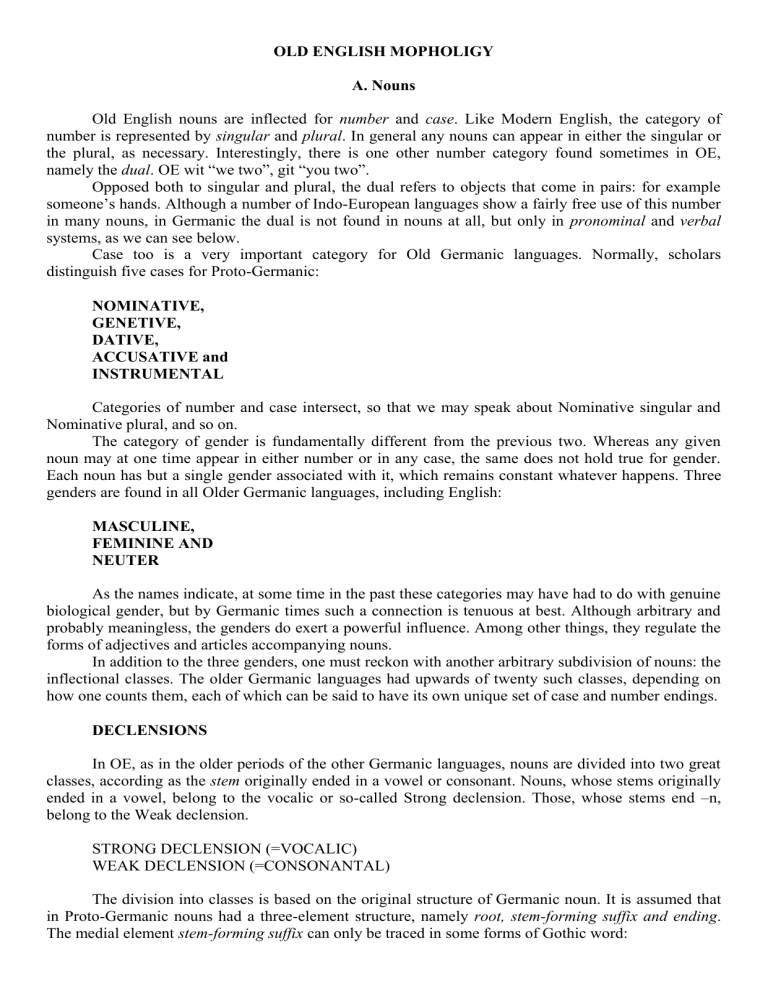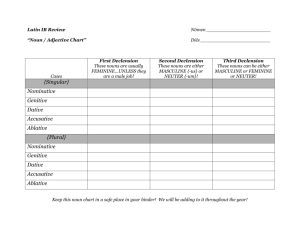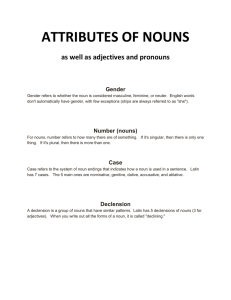
OLD ENGLISH MOPHOLIGY A. Nouns Old English nouns are inflected for number and case. Like Modern English, the category of number is represented by singular and plural. In general any nouns can appear in either the singular or the plural, as necessary. Interestingly, there is one other number category found sometimes in OE, namely the dual. OE wit “we two”, git “you two”. Opposed both to singular and plural, the dual refers to objects that come in pairs: for example someone’s hands. Although a number of Indo-European languages show a fairly free use of this number in many nouns, in Germanic the dual is not found in nouns at all, but only in pronominal and verbal systems, as we can see below. Case too is a very important category for Old Germanic languages. Normally, scholars distinguish five cases for Proto-Germanic: NOMINATIVE, GENETIVE, DATIVE, ACCUSATIVE and INSTRUMENTAL Categories of number and case intersect, so that we may speak about Nominative singular and Nominative plural, and so on. The category of gender is fundamentally different from the previous two. Whereas any given noun may at one time appear in either number or in any case, the same does not hold true for gender. Each noun has but a single gender associated with it, which remains constant whatever happens. Three genders are found in all Older Germanic languages, including English: MASCULINE, FEMININE AND NEUTER As the names indicate, at some time in the past these categories may have had to do with genuine biological gender, but by Germanic times such a connection is tenuous at best. Although arbitrary and probably meaningless, the genders do exert a powerful influence. Among other things, they regulate the forms of adjectives and articles accompanying nouns. In addition to the three genders, one must reckon with another arbitrary subdivision of nouns: the inflectional classes. The older Germanic languages had upwards of twenty such classes, depending on how one counts them, each of which can be said to have its own unique set of case and number endings. DECLENSIONS In OE, as in the older periods of the other Germanic languages, nouns are divided into two great classes, according as the stem originally ended in a vowel or consonant. Nouns, whose stems originally ended in a vowel, belong to the vocalic or so-called Strong declension. Those, whose stems end –n, belong to the Weak declension. STRONG DECLENSION (=VOCALIC) WEAK DECLENSION (=CONSONANTAL) The division into classes is based on the original structure of Germanic noun. It is assumed that in Proto-Germanic nouns had a three-element structure, namely root, stem-forming suffix and ending. The medial element stem-forming suffix can only be traced in some forms of Gothic word: 2 DATIVE PLURAL a-declension Dag – a - m ō-declension Gib – ō - m i-declension Gast – i – m u-declension Sun – u - m n-declension Hana In OE the Vocalic or Strong declension in –a- (PIE –o-) comprises masculine and neuter nouns only. The latter are divided into short-syllable and long-syllable ones. The short-syllable nouns end in – u in NOM, ACC plural, long-syllable ones have no endings. a-stem PLURAL MASCULINE NEUTER stan-as scip-u stan-a scip-a stan-um scip-um stan-as scip-u SINGULAR MASCULINE NEUTER NOM stan scip GEN stan -es scip-es DAT stan -e scip-e ACC stan scip NEUTER heofod-u/hefdu hefd-a hefd-um heofod-u Stems in –a could be supplemented by the preceding sonorant sounds –j- or –w-, in which case the reconstructed suffix had the form of *-ja- or *-wa-. The nouns that fall under *-ja- or *-wadeclension were subject to i-umlaut, e.g. Gothic kuni – OE cynn. Stems in -ō- comprise only feminine nouns. They are also divide into short and long-syllable ones. The variants of this stem are –jo- and –wo-. -ō-stem NOM GEN DAT ACC SINGULAR FEMININE giefu “дар” lār “учення” gief-e lār-e gief-e lār-e gief-e lār-e gief-a gief-a gief-um gief-a PLURAL FEMININE lār-a lār-a lār-um lār-a Stems in –i- comprise masculine, neuter and feminine nouns. The masculine and neuter paradigm correspond to –a-stem paradigm. i-stem SINGULAR MASCULINE NEUTER NOM mete spere GEN -es -es DAT -e -e ACC -e -e FEMININE bēn -e -e -e PLURAL MASCULINE NEUTER met-as sper-u -a -a -um -um -as -u FEMININE bēn-a -a -um -u Stems in –n- include all three genders n-stem SINGULAR PLURAL 3 MASCULINE FEMININE MASCULINE FEMININE NOM hunta “мисливець” GEN DAT ACC -an sunne “сонце” -an hunt-an - sunn-an - There are also minor declensions like –root, -es-, -er-declensions, etc. When analyzing OE texts one has to remember that all nouns have the ending –um for the dative plural in all declensions, and most have –a for genetive plural, and many masculine nouns have a genitive singular in –es, and accusative, nominative plural in –as. But in no nouns is a distinction made between nominative plural and accusative plural. OE relied a good deal for its case distinctions on the adjectives, which had preserved more distinctive endings than the nouns, and on the demonstrative pronoun sē, which still had a large number of forms for different cases and genders. ADJECTIVES Adjectives had different inflections for different genders, and had to agree with the noun in gender. In OE like in Proto-Germanic there two distinct sets of inflections for the adjectives, called the strong and the weak declensions of the adjective. The distinction between the strong and the weak forms of the adjective is traced in OE gōd mann “a good person” – strong from, and the weak form sē gōda mann. Weak declension of adjectives corresponds to the weak declension of nouns (in –n-), though it differs from weak declension of nouns in genitive plural, where we can find the ending –ra. The latter is a borrowing from the strong declension due to the analogy process. Adjectives have the categories of case, gender and number, degrees of comparison. They are declined in accordance with relevant stems. Unlike nouns, adjectives may have five cases, including Instrumental. Degrees of comparison: PG suffixes of the relative degree *iza and *-oza had undergone the rhotacism and the reduction of the first vowel; in OE they coalesced in-ra. PG superlative suffixes *-ist, *-ost- > OE –est, -ost. In those adjectives, where reletive degree suffix ascend to *iza and *-ist, the root vowel was subject to i-mutation. In the adjectives, whose suffixes ascend to *oza and *-ost original vowels correspond to comparison forms. Heard “жорсткий, загартований” – heardra – heardost Hwæt “хоробрий” - hwætra – hwatost Some adjectives have the suppletive forms of comparison, e.g: Gōd – betera, bettra – betst Yfel – wiersa, wyrsa – wierrest, wyrst Micel – māra - mæst




